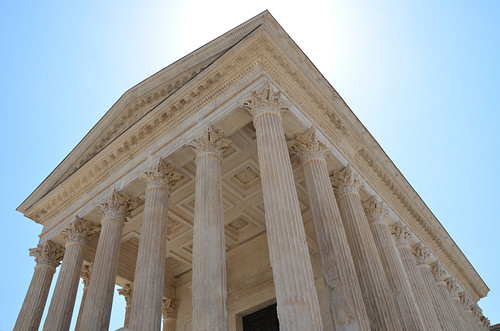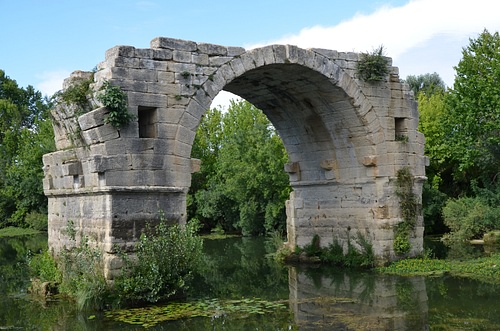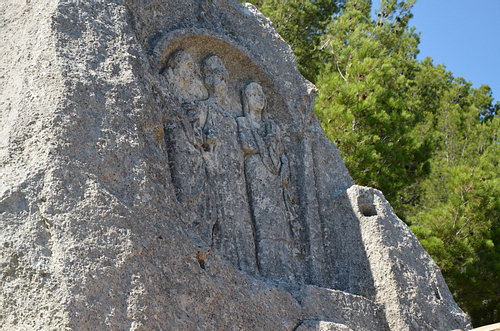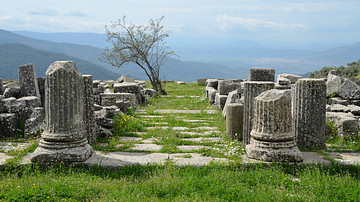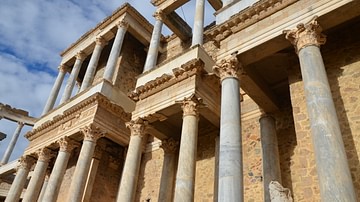Provence has inherited a rich legacy from antiquity, boasting some of the best-preserved Roman ruins in Europe. In the 2nd century BCE, the Romans began their conquest of the region and called it “Provincia Romana,” giving us the region's present name, “Provence.” Thanks to the Pax Romana, which was to last for several centuries, the province, later renamed “Gallia Narbonensis” (after its capital “Narbo Martius” which is present-day Narbonne, France), experienced a period of unprecedented growth. Roads, bridges, and aqueducts were built to eliminate the isolation of the conquered territories, and there are hundreds of ancient sites in Provence. Additionally, replicas of the major monuments of Rome were raised in many urban centers.
Scattered throughout Provence, there are countless ancient monuments that have survived the centuries, allowing us to enjoy what was once a vibrant part of the Roman Empire. On a recent trip to Provence, I followed Roman roads, crossed Roman bridges, and marveled at Roman theaters, arenas, and temples. Here is a list of 10 must-see ancient sites in Provence, France.
1. Nîmes
Nîmes was known to the Romans as “Nemausus”, and it is one of the most impressive ancient sites in France. (It is technically located in Languedoc-Roussillon, but the city has historic and strong ties to Provence.) The name is believed to have been derived from the Celtic god of the spring that originally provided water for the settlement. It was the capital of the Volcae Arecomici — a Gaulish tribe which surrendered to the Roman Republic in 121 BCE — and became a Roman colony sometime before c. 28 BCE. The city has produced wonderful Roman architectural remains including the so-called Maison Carrée (Square House), an admirably preserved first century BCE Corinthian temple commissioned by Marcus Agrippa (right-hand man, son-in-law, and intended successor of Caesar Augustus).
An excellent new film, “Nemausus: The Birth of Nîmes,” is being shown daily every 30 minutes at the Maison Carrée. Shot partially in the Cinecittà studios in Rome, the 22-minute film takes you to the heart of the story of how Nîmes was founded, through the eyes of one family from 55 BCE-90 CE. (You can see a trailer here.)
The amphitheater of Nîmes, known as “les Arènes,” is one of the best preserved in Europe. Built around 70 CE, it could seat upwards of 24,000 spectators. Presently, it still draws large crowds during its two annual bullfights and other public events in the summer.
Other places of interest include the Augusteum/nymphaeum (the so-called Temple of Diana), the Tour Magne and the Porte d'Auguste (the only remnants of the ancient Augustan fortifications) as well as the Castellum divisorium (the terminal point of the aqueduct that brought water to the city).
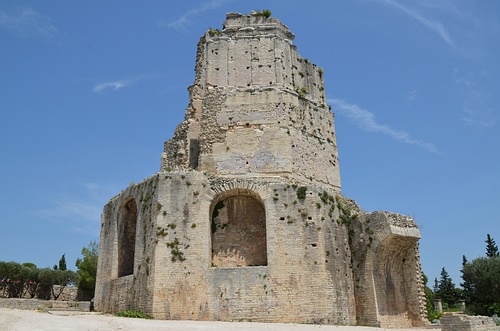
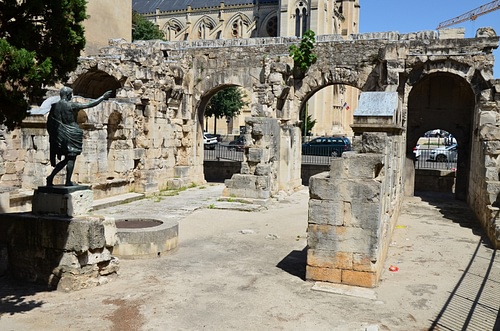
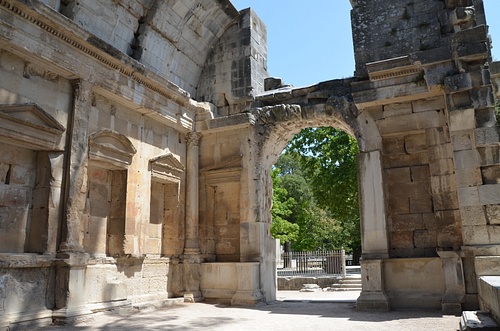
The Musée de la Romanité (Museum of Roman Civilization), is highly recommended. It houses a collection of some 25,000 pieces including exquisite mosaics.
2. Pont du Gard
A true masterpiece of ancient architecture, the Pont du Gard aqueduct is one of the most beautiful Roman ruins in all of Europe. It has been a UNESCO World Heritage Site since 1985 CE.
The Pont du Gard was part of an extended channel built to carry water to Nîmes from a source immediately to the north of the city. The difference in level between the two ends of the aqueduct is only 17 m (56 ft) or an average of 34 cm (13 in) per km, while the bridge descends by a mere 2.5 cm (1 in). The construction of the aqueduct has long been credited to Augustus' son-in-law Marcus Agrippa (64/63-12 BCE), but more recent excavations suggest the construction may have taken place between c. 40-60 CE.
On the site of the Pont du Gard, you will find a museum tracing the history of the Roman aqueduct and water in the Roman world. Models, virtual reconstructions, multimedia screens, and sounds whisk you into the world of the Romans.

3. Arles
Once called the “little Rome of Gaul,” Arles (or Arelate in Latin) occupied an important strategic position at the crossroads between Italy and Spain. In 46 BCE, Julius Caesar founded a Roman colony in this city which had supported him in his long struggle against Pompey. Consequently, the city changed and splendid Roman buildings were built. A number of these Roman structures are still standing. These include the amphitheater (Arènes d'Arles) and the theater (Théâtre Antique), remains of a circus, baths (Thermae of Constantine), a necropolis (the Alyscamps), and a large cryptoporticus built as foundations for the forum. The Roman and Romanesque monuments in Arles have been UNESCO World Heritage Sites since 1981 CE.
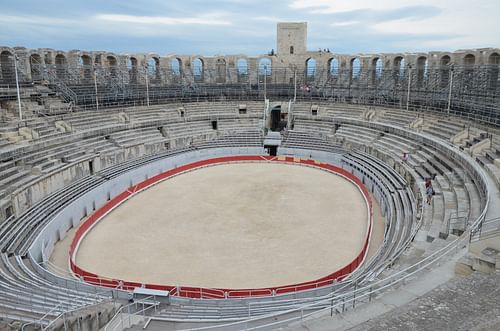
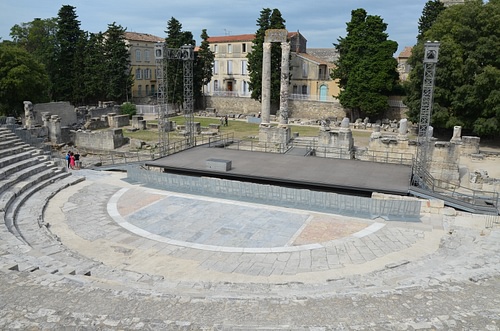
Arles made headlines around the world in 2008 CE when a bust, thought to be of Julius Caesar, was found at the bottom of the Rhône River. Although its identification has been disputed, it is generally considered to be the only known portrait-bust of Julius Caesar carved during his lifetime.
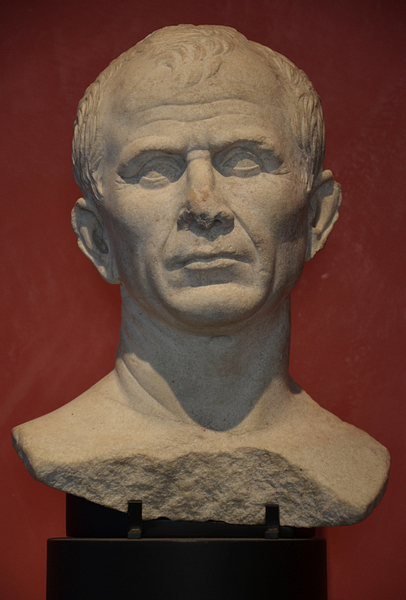
4. Vaison-la-Romaine
With the gradual romanization of the city of Narbonensis, present-day Vaison-la-Romaine (Vasio in Latin) became one of the wealthiest cities in Roman Provence. Nowhere in Provence does a city feel as “Roman” as in Vaison. The ruined remains of the Gallo-Roman city that flourished here, between the 1st and 3rd centuries CE, cover two main sites: La Villasse and Puymin. At La Villasse, a magnificent paved street, raised and colonnaded, runs straight through the central district, flanked by luxurious houses, shops, baths, gardens, and fountains. At Puymin, you can see the remains of the Roman theater (heavily restored), a rich private domus of exceptional size, as well as a porticoed sanctuary.
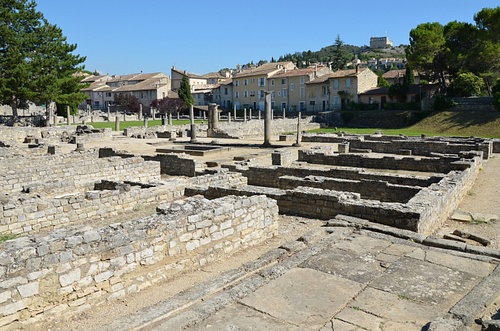
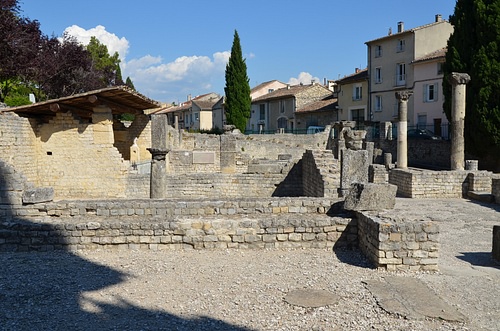
The Roman bridge — built in the first century BCE — spans the Ouvèze River, linking the lower part of the city to the upper medieval part of town. The bridge is unique due to its semicircular 17 m (55 ft) arch. It is still in use and survived a devastating flood, which caused great damage on September 22, 1992 CE.

The Museum of Vaison-la-Romaine, which can be found at the heart of the archaeological remains of Puymin, has some very fine artifacts including the splendid “Peacock Mosaic,” which is 33 m² (355 ft²). There are also marble statues of Hadrian and his wife, Sabina, located in the Roman theater.
5. Glanum
At the heart of the magnificent Alpilles mountains, lies the impressive archaeological site of Glanum at Saint-Rémy-de-Provence, which features the remains of important religious and civic monuments. These ruins present a fine example of ancient urban development. Originally a simple Gaulish settlement built by the Salyens around a sacred spring in the 6th century BCE, the city later expanded due to contact with the ancient Greeks. Glanum also benefited from the construction of the Via Domitia and became a Roman colony in the early years of Augustus' reign (27 BCE-14 CE). Today, Glanum is particularly known for two well-preserved Roman monuments of the first century BCE, known locally as “les antiques”: a mausoleum (one of the best-preserved monuments from the ancient world) and a triumphal arch (one of the earliest built in France).
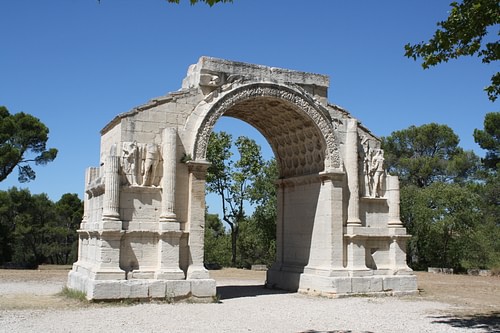

6. Orange
Located in the heart of the Rhône Valley, the Théâtre antique d'Orange is, without a doubt, one of the finest and most interesting ruins from the Roman era. It was designated a UNESCO World Heritage site in 1981 CE. Its magnificent scaenae frons (stage wall) is incredibly well-preserved. The cavea could hold as many as 10,000 spectators and was divided into three separate sections to accommodate spectators according to their social rank. The Roman Theater of Orange was a great center for entertainment in Roman times and still draws large audiences to musical events even today.
The 20m-high (65 ft-high) Triumphal Arch of Orange, built during the reign of Augustus on the Via Agrippa (a road leading to Lyon, France), is one of the largest and best preserved of its kind. Erected as a tribute to the veterans of the Second Gallic legion, who founded the town, the arch is richly decorated with various low reliefs commemorating the establishment of the Pax Romana. Eventually, the monument was dedicated to Emperor Tiberius (r. 14-37 CE) to commemorate the victories of General Germanicus over the German tribes in the Rhineland.
The Art and History Museum of Orange, just opposite the ancient theater, exhibits a delightful and impressive work of Roman art: a recently restored centaur mosaic. Reliefs that decorated the stage wall of the theater are also on display in the rooms of the ground floor.
7. The Pont Flavien
In Provence, as everywhere else, the Romans proved what outstanding engineers they were by adapting bridges to meet the geophysical characteristics of rivers. Of all the bridges built in the province, the Pont Flavien, at Saint-Chamas, is the only surviving example of a Roman bridge flanked by triumphal arches. The name “Flavien” refers to a certain Lucius Donnius Flavius, and an inscription on the bridge itself states that it was built at his instigation. The bridge was completed around 12 BCE and consists of a single arch spanning the Toulourde River on the Via Julia Augusta.
8. Ambrussum
Ambrussum is a magnificent Gallo-Roman archaeological site which has revealed an exceptional collection of buildings from the Gallic and Roman periods. It is close to the modern town Lunel, located between Nîmes and Montpellier. The site is notable for its Iron age settlement, its Roman staging post on the Via Domitia and its celebrated bridge spanning the Vidourle River, the Pont Ambroix. At the end of the 4th century BCE, a Gaulish tribe — the Volscians — settled and built a city surrounded by strong ramparts and towers (some of which can still be seen). The Romans conquered the area in 120 BCE and the city grew rapidly; thereafter, a new district was created next to the Vidourle River, serving as a staging post for travelers. The Via Domitia at the foot of the settlement and a paved road leading out of the settlement are visible along with traces of Roman chariot tracks.
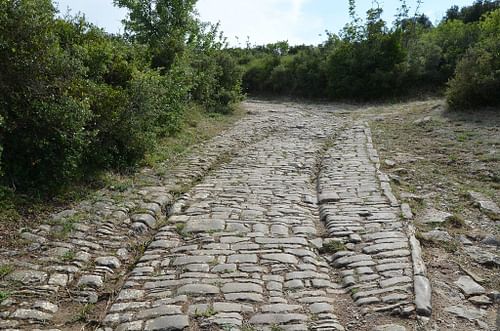
The Ambroix Bridge is unquestionably the most spectacular ruin of this ancient site. It is an impressive work of engineering, which allowed the Via Domitia to cross the Vidourle River. It is thought to have had 11 arches and to have been over 175 m (574 ft) in length. Unfortunately, the ravages of time and numerous floods took out all but one arch. Two had stood as recently as 81 years ago — which are reflected in Gustave Courbet's famous 1857 CE painting of the bridge — but a violent flood in 1933 CE left only one arch standing.
9. The Pont Julien
The Pont Julien, owing its name to the nearby city of Apt (Julia Apta in Latin), whose territory it was built upon, is a beautiful three-arched bridge spanning over the Calavon River. Today, it is close to the town of Bonnieux, France. It was originally built in 3 BCE on the Via Domitia, an important Roman road that connected Italy and Spain through the Roman province of Gallia Narbonensis. (Gallia Narbonensis encompassed Roussillon, Languedoc, and Provence in southern France.) The Pont Julien is perfectly preserved and remained in use until a neighboring bridge was built in 2005 CE. However, it is now reserved for pedestrians and cyclists only.
10. Les Trémaïé
Below the medieval citadel and ruined castle of Les Baux-de-Provence stands a bas-relief skillfully carved on a block of limestone known as “Les Trémaïé.” It depicts three life-size standing figures; a man and two women, in Roman clothing. Archaeologists have generally believed that the carvings date from the Augustan period. However, the characters' identities are hotly debated. Some see the figures as the Roman consul, Marius, his wife, Julia, and the Syrian prophetess, Martha. Traditionally, Christians have seen the “Three Marys” (hence the name “Trémaïé”), all of whom were followers of Christ. An epitaph was identified below the bas-relief and states with absolute certainty that this was a Gallo-Roman votive relief.

